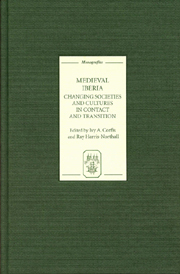Book contents
- Frontmatter
- Contents
- Acknowledgements
- Introduction
- Part 1 SOCIAL AND CULTURAL MINORITIES IN CHANGING SOCIETIES
- Part 2 CONTACT AND CONFLICT: PERSPECTIVES ON HISTORY AND CULTURE
- Part 3 TRANSMISSION OF LEARNING AND TEXTS IN CHANGING CULTURES
- Hermes Trismegistus in General Estoria II
- Pharmaceutical Fictions: Celestina's Laboratory and the Sixteenth-Century Medical Imaginary
- Spanish and Portuguese Scholars at the University of Paris in the Fourteenth and Fifteenth Centuries: The Exchange of Ideas and Texts
- The Primary Audience and Contexts of Reception of Thirteenth-Century Castilian cuaderna vía Poetry
- Editorial Interference in Amadís de Gaula and Sergas de Esplandián
- Part 4 LINGUISTIC CONTACT AND CHANGE
- Index
Pharmaceutical Fictions: Celestina's Laboratory and the Sixteenth-Century Medical Imaginary
from Part 3 - TRANSMISSION OF LEARNING AND TEXTS IN CHANGING CULTURES
Published online by Cambridge University Press: 12 September 2012
- Frontmatter
- Contents
- Acknowledgements
- Introduction
- Part 1 SOCIAL AND CULTURAL MINORITIES IN CHANGING SOCIETIES
- Part 2 CONTACT AND CONFLICT: PERSPECTIVES ON HISTORY AND CULTURE
- Part 3 TRANSMISSION OF LEARNING AND TEXTS IN CHANGING CULTURES
- Hermes Trismegistus in General Estoria II
- Pharmaceutical Fictions: Celestina's Laboratory and the Sixteenth-Century Medical Imaginary
- Spanish and Portuguese Scholars at the University of Paris in the Fourteenth and Fifteenth Centuries: The Exchange of Ideas and Texts
- The Primary Audience and Contexts of Reception of Thirteenth-Century Castilian cuaderna vía Poetry
- Editorial Interference in Amadís de Gaula and Sergas de Esplandián
- Part 4 LINGUISTIC CONTACT AND CHANGE
- Index
Summary
In a curious and lengthy dialogue in Fernando de Rojas' Celestina, Pármeno offers his love-struck master an extensive list of herbs, minerals, animal parts and sundry concoctions that the go-between Celestina stores or manufactures in her dilapidated shack by the river (Rojas 34–9). While Celestina knocks on Calisto's door, a concerned Pármeno inventories more than one hundred substances and alludes to the fact that there are thousands more on Celestina's shelves. Some of these are common and seemingly benign, such as perfumes, oils and ointments made from jasmine, lemons and rosemary; others are notably arcane, such as a viper's tongue, stones from an eagle's nest, a quantity of quail heads and a hangman's rope. Within the diegesis, Pármeno's objective is twofold; he wants to prove that he has firsthand knowledge of Celestina's illicit practices, and by extension, he hopes to dissuade Calisto from employing Celestina as mediator for his pathologized amorous desire. The strategy, however, fails to convince Calisto, who quickly dismisses Pármeno's objections and orders his servant to let the aging bawd enter.
Pármeno's lengthy disclosure of the materials in Celestina's laboratory not only fails to discourage his master, but also may have unwittingly captured Calisto's imagination by insinuating that Celestina, with her enormous, wellstocked laboratory, is ideally suited to concoct tangible remedies for his condition. The late fifteenth and early sixteenth centuries are a period of expanding interest in the discovery, creation and dissemination of new pharmaceutical remedies.
- Type
- Chapter
- Information
- Medieval IberiaChanging Societies and Cultures in Contact and Transition, pp. 99 - 109Publisher: Boydell & BrewerPrint publication year: 2007



